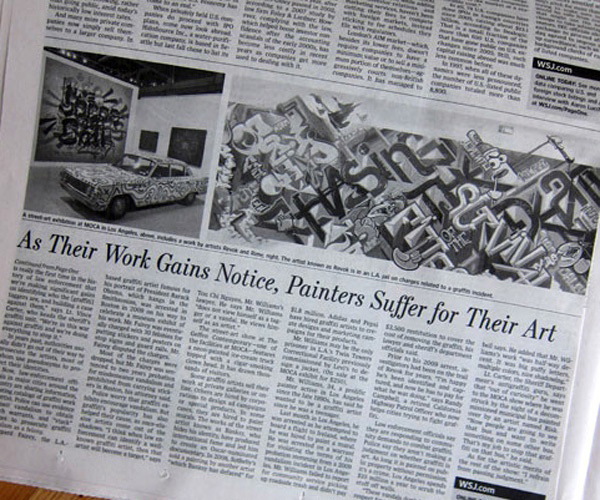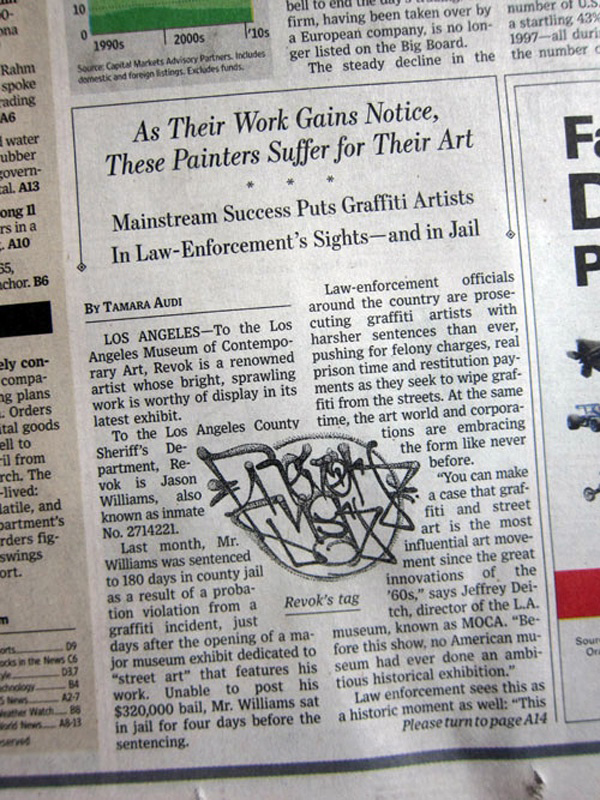Revok is the first person ever to tag the cover of The Wall Street Journal.

Here’s the article written by Tammy Audi:
As Their Work Gains Notice, These Painters Suffer for Their Art.
Mainstream Success Puts Graffiti Artists in Law-Enforcement’s Sights—and in Jail.
LOS ANGELES—To the Los Angeles Museum of Contemporary Art, Revok is a renowned artist whose bright, sprawling work is worthy of display in its latest exhibit.
To the Los Angeles County Sheriff’s Department, Revok is Jason Williams, also known as inmate No. 2714221. Last month, Mr. Williams was sentenced to 180 days in county jail as a result of a probation violation from a graffiti incident, just days after the opening of a major museum exhibit dedicated to “street art” that features his work. Unable to post his $320,000 bail, Mr. Williams sat in jail for four days before the sentencing.
It may be illegal on the street, but inside the Los Angeles Museum of Contemporary Art, a new exhibit celebrates the history of graffiti, featuring work by artists like Banksy and Shepard Fairey. WSJ’s Tammy Audi reports.
Law-enforcement officials around the country are prosecuting graffiti artists with harsher sentences than ever, pushing for felony charges, real prison time and restitution payments as they seek to wipe graffiti from the streets. At the same time, the art world and corporations are embracing the form like never before.”You can make a case that graffiti and street art is the most influential art movement since the great innovations of the ’60s,” says Jeffrey Deitch, director of the L.A. museum, known as MOCA. “Before this show, no American museum had ever done an ambitious historical exhibition.”
Law enforcement sees this as a historic moment as well: “This is really the first time in the history of law enforcement that we’re making significant gains on identifying who the [graffiti] taggers are, and building a case against them,” says Lt. Vince Carter, who heads the sheriff’s graffiti unit. “We’re in this war against graffiti and we’re doing everything to stop it.”
In years past, authorities usually didn’t go out of their way to prosecute the artists, most of whom use pseudonyms to protect their identities.
Now, law-enforcement officials in major cities around the country are sharing information, creating catalogs of graffiti work by artist. Police can use evidence of past vandalism to obtain search warrants, and “stack” charges to prosecute graffiti vandalism as a felony.
Shepard Fairey, the L.A.-based graffiti artist famous for his portrait of President Barack Obama, which hangs in the Smithsonian, was arrested in Boston in 2009 on his way to celebrate a museum exhibit of his work. Mr. Fairey was eventually charged with 30 felonies for putting stickers and posters on stop signs and guard rails. Mr. Fairey disputed the charges.
Most of the charges were dropped, but Mr. Fairey was sentenced to two years probation for misdemeanor vandalism and prohibited from carrying stickers in Boston, his attorney said.
Police worry that graffiti exhibits encourage vandalism. But graffiti’s popularity has also helped their cause, as once-elusive artists come out of the shadows. “I think when law enforcement can identify a well-known graffiti artist, then that artist will become a target,” says Ton Chi Nguyen, Mr. Williams’s lawyer. He says Mr. Williams “does not view himself as a tagger or a vandal. He views himself as an artist.”
The street-art show at The Geffen Contemporary—one of the facilities at MOCA—features a neon-painted ice-cream truck topped with a cigar-smoking clown head. It has drawn thousands of visitors.
Some graffiti artists sell their work at private galleries or online. Others are hired by corporations to design ad campaigns or special products. In some cases, they are hired to paint murals. The works of the street artist known as Banksy, who hides his identity, have produced international fame and led him to create an Oscar-nominated documentary. In 2008, Sotheby’s sold a painting by another artist “which Banksy has defaced” for $1.8 million. Adidas and Pepsi have hired graffiti artists to create designs and marketing campaigns for their products.
Mr. Williams may be the only prisoner in L.A.’s Twin Towers Correctional Facility previously commissioned by Levi’s to design a jacket. (On sale at the MOCA exhibit for $250).
Mr. Williams, 34, a prolific painter active in Los Angeles since the late 1990s, has said he wanted to be a graffiti artist since he was a teenager.
Last month in Los Angeles, he was arrested as he attempted to board a flight to Ireland, where he was hired to paint a mural. He was arrested on a warrant for violating the terms of his probation stemming from a 2009 vandalism incident in Los Angeles. Mr. Williams failed to report for community service picking up roadside trash and didn’t pay $3,500 restitution to cover the cost of removing the graffiti, his lawyer and sheriff’s department officials said.
Prior to his 2009 arrest, investigators had been on the trail of Revok for years. “I’m happy he’s been identified and captured, and now he has to pay for what he was doing,” says Randy Campbell, a retired California Highway Patrol Officer who now helps cities trying to fight graffiti.
Law enforcement officials say they are responding to community demands to combat graffiti. Police say they aren’t making a judgment on whether graffiti is art. As long it is painted on public property without permission, it’s a crime. Los Angeles spends $10 million a year to scrub the stuff off walls.
“These vandals don’t have any respect for property,” Mr. Campbell says. He added that Mr. Williams’s work “was half-way decent. It was big puffy letters, multiple colors, nice shadowing.”
Lt. Carter, the Sheriff Department’s antigraffiti guru, says that “out of curiosity” he went to the MOCA show where he was struck by the sight of a decommissioned municipal bus painted over by an artist named Risk. “Now people are going to see that bus and want to write something on some other bus. That’s my job to stop that graffiti on that bus,” he said.
As for the artistic merits of the rest of the show: “I refrain from passing judgment.”
Contact: tammy.audi@wsj.com
Source: wsj.com
More info:
– KnownGallery.com
– Revok1.com

